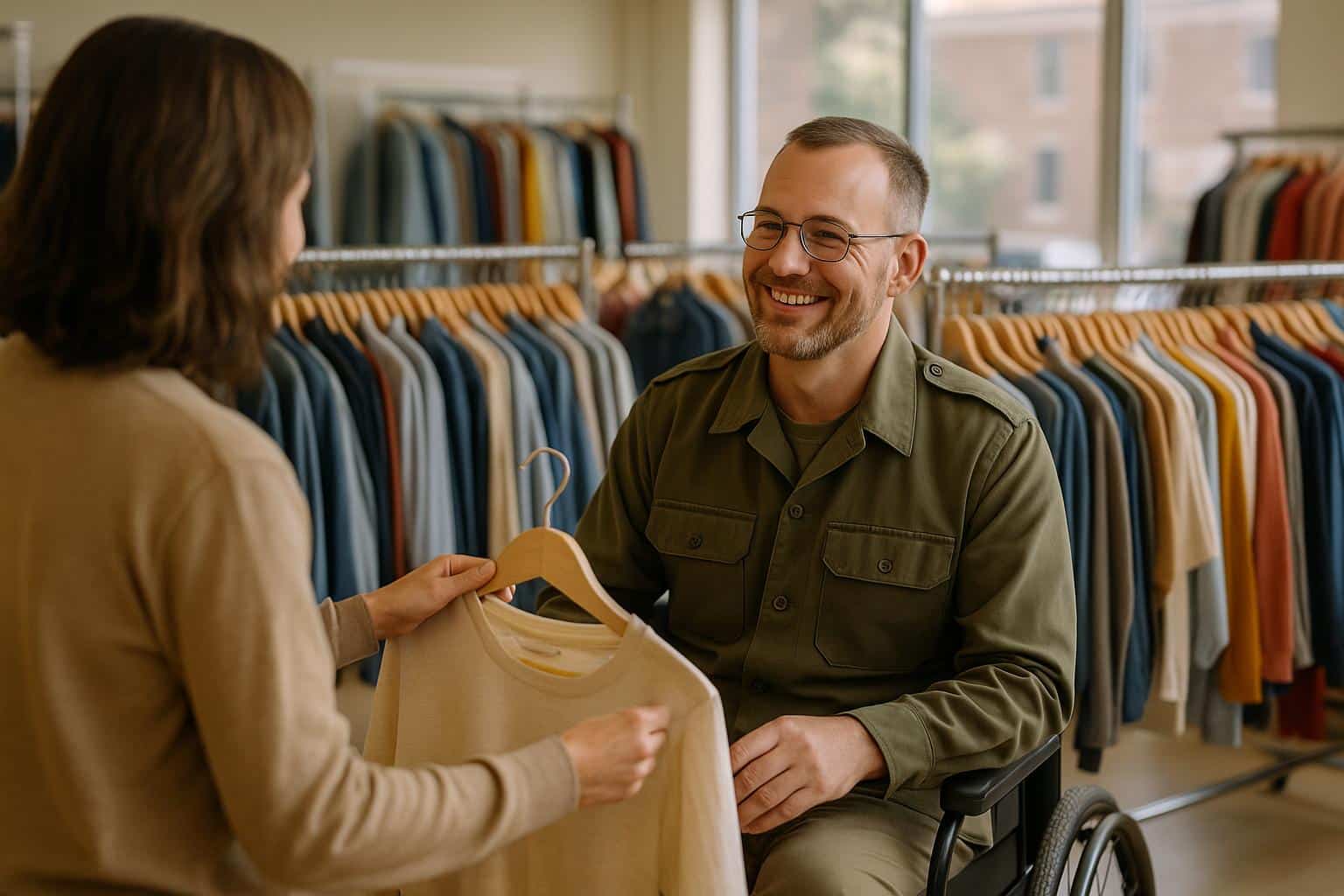
Thrift stores are more than just places to shop – they’re a lifeline for families, a solution to waste, and a boost to local economies. Here’s why they matter:
- Affordable Goods: Families save big by buying secondhand, with items like $3 sweaters or $10 dish sets making tight budgets manageable.
- Job Creation: These stores employ people facing challenges, like veterans and those reentering the workforce, offering career growth and stability.
- Waste Reduction: By reselling and recycling items, thrift stores help cut down on the 11 million tons of textile waste Americans produce annually.
- Community Connections: Thrift stores serve as gathering spaces, hosting events and supporting local charities.
From saving money to reducing waste, thrift stores strengthen communities and make a lasting impact.
Affordable Shopping for Economic Relief
When money is tight, thrift stores provide a lifeline for many. They turn items that might otherwise be out of reach into affordable options, helping families stretch their budgets further.
Low-Cost Essentials for Everyone
Thrift stores are treasure troves of affordable finds. Imagine snagging a designer coat that normally costs hundreds for just $30, or picking up a gently used sweater for as little as $3. A set of dishes that might retail for $50 could be yours for only $10. Even brand-new items pop up – like coats priced at $20, cashmere sweaters for $11, or wool-blend sweaters for under $3 .
“The unaffordable becomes the affordable.” – Lauren Breslow, Reddz’s assistant store manager
Beyond the basics, thrift stores often surprise shoppers with rare finds, sometimes still sporting their original tags. You might stumble upon a perfect pair of J Brand jeans at a fraction of their retail price. This thrill of discovery makes thrift shopping not just economical but also exciting.
These savings provide families with breathing room in their budgets, allowing them to allocate funds toward other critical needs.
How Thrift Stores Help Family Budgets
Thrift stores play a crucial role in helping families manage their finances. By offering affordable alternatives, they reduce everyday expenses and foster financial stability. In fact, 4 out of 5 people have shopped or are open to shopping at secondhand stores during tough financial times. Parents, for example, can buy school clothes at a fraction of the cost, freeing up money for essentials like groceries, utilities, or medical bills. It’s no wonder that 75% of U.S. consumers – and an impressive 83% of Generation Z – have either shopped or are willing to shop for secondhand apparel.
The economic challenges brought on by the COVID-19 pandemic highlighted just how vital thrift stores are. During this period, 88% of consumers turned to thrifting, with the primary motivation being to save money. Thrift shopping also allows families to explore new styles without breaking the bank.
“It’s to reclaim old clothing. It’s to give new life to pieces and to allow people to be inventive with their style on a budget.” – Amanda Estevez, COL ’23
Creating Local Jobs and Economic Growth
Thrift stores are more than just budget-friendly shopping destinations – they play a key role in strengthening local economies. By creating jobs and reinvesting in their communities, these stores help address economic challenges while uplifting neighborhoods. One of their most impactful contributions is providing employment opportunities to those who face barriers in the traditional job market, including veterans and diverse workers.
Jobs for Veterans and Diverse Workers
Thrift stores have become essential lifelines for individuals seeking a second chance or struggling to find work due to unique challenges. Veterans, people with disabilities, and those reentering the workforce often find meaningful employment through these community-driven businesses.
In the South alone, thrift stores employ over 1,500 workers, offering not just a paycheck but also a sense of dignity and a path toward financial independence. Veterans, in particular, benefit from these opportunities. Programs supported by the U.S. Department of Labor prioritize job training for veterans and their families. Many thrift stores actively participate in these initiatives, ensuring veterans have access to careers that support their unique needs.
Take Red Racks Thrift Stores, for example – a veteran-owned organization operating in Missouri. They provide career paths with benefits and growth opportunities tailored to support veterans and their communities. Similarly, the Fort Rucker base thrift shop highlights how these businesses can enhance the well-being of entire military communities. Donna Woodham, Manager of Fort Rucker’s Thrift Shop, shares:
“It is an amazing feeling to be able to witness a change in lives through donations and contributions to functions and programs that impact so many lives.”
Beyond providing immediate employment, these roles help workers build skills in retail, customer service, and management, setting them up for long-term career success. The experience gained in these positions often serves as a foundation for advancement into other industries.
Career Growth and Training Programs
Thrift stores don’t just offer jobs – they provide training and real opportunities for career growth. Unlike many entry-level retail positions, roles in thrift stores often come with comprehensive benefits and structured pathways for advancement.
Employees develop practical skills in areas like inventory management, pricing, customer relations, and community outreach. Many thrift organizations also offer specialized training in tasks like textile sorting, quality assessment, and donation processing – skills that are increasingly valuable in today’s circular economy.
Organizations such as Goodwill take this a step further by funding job training programs. These initiatives ensure that employees not only excel in their current roles but also have the tools to pursue broader career opportunities.
The ripple effects of these efforts extend far beyond the individuals employed. By keeping wages circulating locally, thrift store employees contribute to a multiplier effect that benefits nearby businesses and strengthens the entire economic ecosystem. The cycle of donations, recycling, and resale not only supports sustainability but also drives ongoing economic activity and community development.
This approach creates a win-win scenario: workers gain stability and valuable experience, while local economies grow stronger and more resilient. By reducing unemployment and encouraging local spending, thrift stores help build communities that are better equipped to thrive, even in challenging times.
Reducing Waste Through Recycling
Thrift stores play an essential role in cutting down waste by giving donated items a second chance at life. These community-driven spaces turn what could have been landfill-bound goods into resources that benefit families and neighborhoods.
In the United States, the problem of textile waste is staggering. Each year, Americans produce 16 million tons of textile waste, making up just over six percent of all municipal waste. To make matters worse, over three million tons of used clothing are incinerated annually, while nearly 10 million tons end up in landfills. On average, each person discards about 70 pounds of clothing and textiles every year. Recycling and reusing these materials not only helps protect the environment but also strengthens local communities by providing affordable goods.
Keeping Items Out of Landfills
Thrift stores extend the usefulness of donated items by accepting clothing, furniture, household goods, and more. Through resale, these items can serve multiple households over time instead of being tossed away. For example, Red Racks focuses on extending the life of products by carefully selecting quality donations, ensuring that usable items stay out of the waste stream.
Beyond keeping items out of landfills, secondhand shopping reduces the demand for new products. This means less energy and fewer resources are needed for manufacturing. The result? Lower carbon emissions, reduced water consumption, and less reliance on raw materials – benefits that ripple across various industries.
What Happens to Unsold Items
Even with the best efforts, not every donated item finds a new home. At Red Racks Thrift Stores, unsold goods aren’t simply discarded. Instead, these items are sent to local recycling programs, where they’re either transformed into new products or broken down into raw materials. This approach ensures that even items without resale potential contribute to a sustainable, circular economy, keeping waste out of landfills and supporting environmentally conscious practices.
Building Community Connections
Thrift stores do more than just sell secondhand items – they serve as gathering places where neighbors connect, fostering a sense of togetherness and strengthening community ties. These stores often evolve beyond their role as retail spaces, becoming vital hubs for social interaction. While they help reduce waste and create jobs, they also nurture the personal relationships that are essential to vibrant communities.
Thrift Stores as Community Hubs
Thrift stores naturally bring together people from diverse backgrounds. Whether it’s customers hunting for hidden gems or volunteers working side by side, these spaces encourage interaction and connection. Many stores go further by hosting events like DIY workshops, clothing swaps, and themed gatherings. These activities turn shopping into a shared experience, sparking conversations and creating opportunities for people to bond. This social role adds another layer to the economic and environmental benefits thrift stores provide, amplifying their influence on the local community.
Supporting Local Charities and Initiatives
The positive impact of thrift stores often extends far beyond their walls. Take Red Racks Thrift Stores, for example. This veteran-owned organization has been a part of Missouri’s community since 1958. Managed by Disabled American Veterans, Red Racks operates 12 locations that not only generate local jobs but also reinvest earnings to support veterans, strengthen community programs, and promote eco-conscious recycling efforts.
“Help your local community and Disabled American Veterans by donating gently used or new items anytime between 9am and 9pm.”
Every donation, purchase, and volunteer effort at a thrift store creates a ripple effect. These stores provide affordable goods, reduce waste, create jobs, and weave stronger social connections. Red Racks, in particular, exemplifies this by reinvesting in local initiatives, supporting veterans, and contributing to sustainability – all while fostering a sense of community.
Case Study: Red Racks Thrift Stores and Community Impact
Red Racks Thrift Stores exemplify the multifaceted benefits of thrift stores, from economic relief to job creation and waste reduction. Operating in over 10 locations across Missouri, this veteran-owned organization blends retail operations with a mission to support the community in impactful ways.
Veteran-Owned and Community-Driven
Owned and managed by Disabled American Veterans (DAV), Red Racks connects every purchase directly to programs that benefit veterans. These initiatives provide essential services such as medical care, job training, and housing assistance for veterans transitioning to civilian life. According to DAV, Red Racks has supported between 10,000 and 20,000 veterans in Missouri alone.
“Those people that are currently enlisted, this is their future, so we want to build upon that foundation.” – Chandra Regan, Business Operations Manager
“They were able to give me medication, give me camaraderieship, help me through those times for me and my family.” – Gerald Caldwell
In addition to its focus on veterans, Red Racks actively promotes environmentally conscious practices.
Recycling and Eco-Conscious Initiatives
Red Racks accepts donations year-round, ensuring usable items are kept out of landfills and offering an alternative to fast fashion. The organization encourages shoppers to opt for natural fibers like cotton and linen, helping reduce microplastic pollution. By collaborating with local recyclers, Red Racks contributes to the growing $28 billion resale market, supporting a circular economy that benefits both the planet and the community.
Empowering Careers and Economic Growth
Red Racks not only creates jobs but also provides employees with clear career pathways and competitive benefits. Workers enjoy paid vacation, personal and holiday leave, group medical/dental/vision insurance, accident insurance, birthday leave with pay, short-term disability, and employee discounts.
Career growth is a priority at Red Racks. For instance, Salvador, who began as a cashier in 2007, rose through the ranks to become the youngest store manager and later a district manager, overseeing multiple locations. Similarly, Carol has built a lasting career with the company since 2002.
| Position | Annual Salary Range | Hourly Pay Range |
|---|---|---|
| Assistant Manager | $35,259 per year | – |
| Store Manager | $50,224 per year | – |
| Part-Time Cashier | – | $13 per hour |
| Operations Supervisor | – | $23 per hour |
Salary data reflects reported figures. Red Racks also invests in its workforce through internal management training, paving the way for employees to advance within the organization. By continuously accepting applications and tailoring job openings to individual store needs, Red Racks ensures flexibility in addressing employment demands. These efforts not only transform individual lives but also strengthen local economies, showcasing the broader impact thrift stores can have on communities.
How Thrift Stores Transform Communities
Thrift stores play a powerful role in reshaping communities by saving money, creating jobs, and cutting down on waste – all through a sustainable approach. Their impact ripples through every corner of community life, from easing financial pressures on families to encouraging eco-friendly practices.
On the economic front, thrift shopping offers substantial savings. Shoppers save an average of $1,800 annually by opting for secondhand goods, while 62% of Gen-Z and millennials now lean toward secondhand purchases instead of buying new. This shift not only makes life more affordable but also aligns with broader efforts to extend product lifespans and reduce waste.
Environmentally, thrift stores are a crucial ally in reducing the fashion industry’s impact. With the sector responsible for 10% of global carbon emissions and Americans discarding over 11 million tons of textiles every year, the stakes are high. By keeping clothing in circulation, thrift stores help cut down on landfill waste and carbon emissions – reusing just 1,000 tons of clothing can prevent about 2,500 tons of CO2 emissions.
The social benefits are just as meaningful. Thrift stores provide jobs and fund vital community programs, strengthening local economies in the process. Take Red Racks, for example – a veteran-owned organization that supports disabled veterans, fosters career growth, and promotes environmental responsibility throughout Missouri. Families get to stretch their budgets while uncovering unique finds, and the community gains through job creation and waste reduction.
When viewed together, these economic, environmental, and social advantages highlight how thrift stores go beyond meeting individual needs – they uplift entire communities. As the global secondhand apparel market grows from $138 billion in 2021 to $211 billion in 2023, with projections hitting $351 billion by 2027, thrift stores are set to play an even greater role in fostering resilient, sustainable communities – one purchase at a time.
FAQs
How do thrift stores help communities reduce waste and protect the environment?
Thrift stores are an important part of cutting down on waste by giving items like clothing, furniture, and other goods a second chance instead of letting them pile up in landfills. By promoting the reuse of these products, they help conserve resources and lessen the need for producing new items – a process that often demands a lot of energy and raw materials.
These stores also play a key role in recycling by finding new purposes for unsold goods. This approach not only reduces waste but also encourages more environmentally conscious shopping habits. Plus, they make it easier for people to choose eco-friendly options while keeping expenses low.
What career opportunities are available at thrift stores, and is there room for growth?
Working at a thrift store opens the door to various career opportunities, such as store management, inventory coordination, and customer service. Depending on your skills and interests, you can also advance into leadership roles or explore specialized positions within the organization.
Thrift stores often offer perks like benefits and chances for professional growth, making them an appealing option for those who want to develop a long-term career while making a positive impact in their local community.
How do thrift stores make a positive impact on local communities beyond offering affordable shopping?
Thrift stores contribute significantly to the strength and well-being of local communities in multiple ways. For starters, they provide job opportunities, often offering benefits and chances for advancement, which bolsters the local economy. On top of that, many thrift stores channel their proceeds or donate unsold goods to charities, supporting essential programs like housing assistance, educational initiatives, and services for veterans.
These stores also champion environmental responsibility by recycling and reusing items, cutting down on waste and helping to protect the planet. Beyond their retail function, thrift stores often organize community events and outreach programs, creating a sense of belonging and encouraging active participation among neighbors. This makes them more than just a shopping destination – they serve as vital hubs of community support and environmental stewardship.





